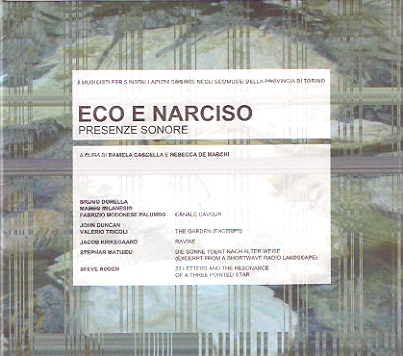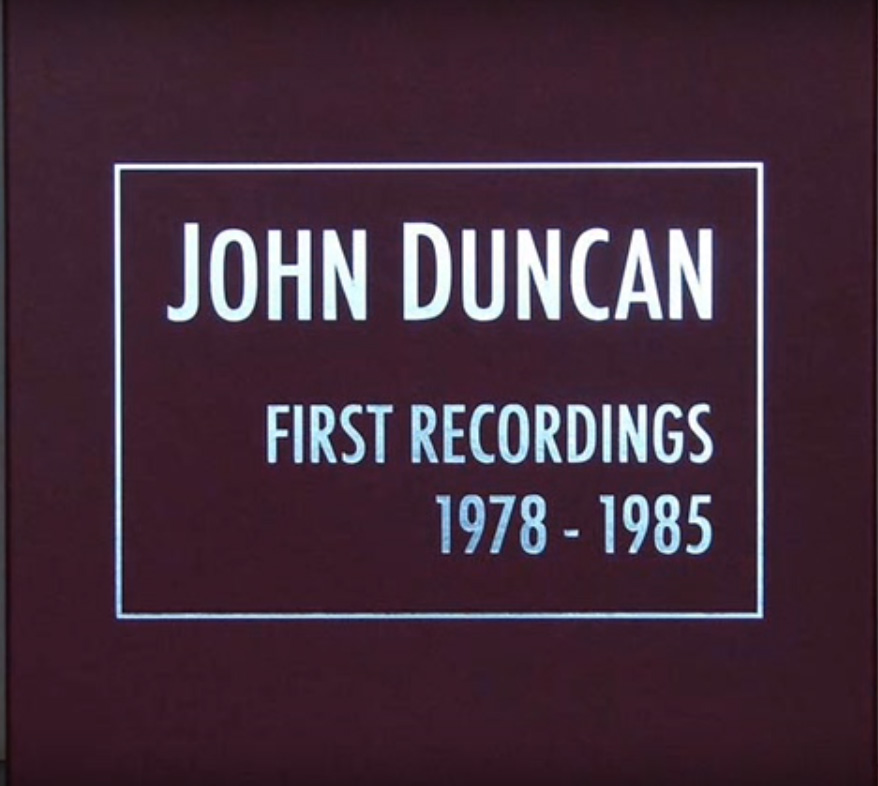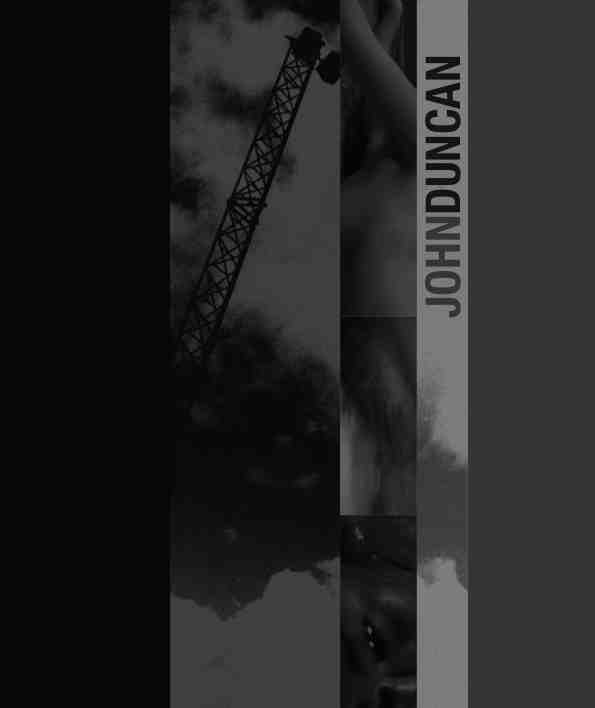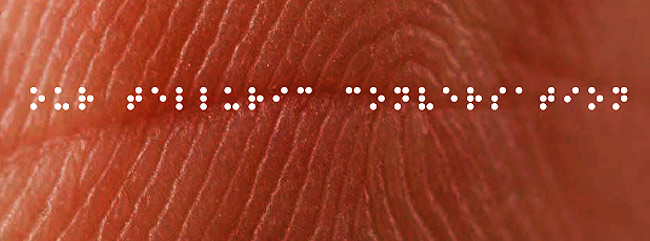The GARDEN (excerpt)
2006John Duncan and Valerio Tricoli
Composed from voice recordings made by John Duncan and Valerio Tricoli in Bologna for the installation THE GARDEN at IPCA Ecomuseo, Ciriè.
Mastered by Valerio Tricoli and John Duncan at Studio Shifting Position, Bologna.
Included on ECO E NARCISO: PRESENZE SONORE
CD and 35 pp. full color booklet in 4-panel digipak released by Eco e Narciso, Torino
Also included: Bruno Dorella/ Marco Milanese/ Fabrizio Modonese Palumbo, Jacob Kirkegaard, Stephan Mathieu, Steve Roden

JOHN DUNCAN: First Recordings 1978-1985
2006John Duncan
VOD33
3-lp box set with DVD video and 20pp. lp-sized booklet.
Lp's:
DARK MARKET BROADCAST
STATION EVENT
NO / PROBE / GAIN
DVD:
PRAYER
Duncan's first releases on cassette. All recordings mastered from the original cassette masters.
Produced by Vinyl On Demand, Friedrichshafen
VOD33
The growing interest in John Duncan's work as a composer, performer and conceptual artist shows that even normal folk, if subjected to the right suggestions and stimuli, are able to recognize real talent, independently from their religious, sociopolitical and personal convictions. Duncan, for many years only championed by discerning fellow artists and independent-minded writers, has by now reached an iconic status which time will only help to enhance, as the man from Wichita remains a cutting-edge explorer who always manages to stick a salt finger in the wounds of truth. First Recordings 1978-1985 is a gorgeous 3-LP box set, a spartan black-and-grey artifact containing music originally released on low-budget and even lower-circulation cassettes and vinyls. It's a fascinating view of several back-pages in Duncan's book, which will bring back memories of youth for those who have been following him since the early days, when Viennese Aktionism and noise-boosted sonic terrorism were major elements in his work. Yet the most striking track on offer is "NO", a Reichian (Wilhelm, not Steve) performance based on therapeutic anti-aggression hyperventilation exercises that took place in Los Angeles' KPFK station's open stage studio in 1978. Duncan's breathing starts normally, then becomes more and more violent until his gasps morph into desperate cries for help, as if he were being subjected to torture; snippets of pre-recorded sentences complement the whole. It's an intensely disturbing, distressing piece. The rest is equally compelling: "DARK MARKET BROADCAST" is based on masses of shortwaves and unrecognizable utterances, transmitted by Duncan via pirate FM radio in 1985 when he lived in Tokyo, while "STATION EVENT" is a recording of Tom Recchion and Michael LeDonne-Bhennet improvising live on KPFK on percussion and woodwinds while Duncan handles listeners' phone calls, putting their comments and rants on the air. The set also contains a DVD with two early videos, whose content could be stomach-churning for many; let's just say that you should keep the thing away from curious kids, if you have any.
-- Massimo Ricci, Paris Transatlantic
More reviews

JOHN DUNCAN: Work 1975-2005
2006John Duncan
104pp. full color book with audio CD included on back cover.
Contributions by Daniela Cascella, Leif Elggren, Cosey Fanni-Tutti, Carl Michael von Hausswolff, Mike Kelley, Brandon LaBelle, Paul McCarthy, Tom Recchion, Takuya Sakaguchi and Giuliana Stefani.
Design and Layout by Marco Brollo.
Produced by Errant Bodies Press, Copenhagen
ISBN-10: 0-9772594-2-0
ISBN-13: 978-0-9772594-2-7
Industrial music has gone from being an obscure form of art music to a full-scale post-Punk semi-pop genre. Japanoise, Black Metal, Grind Core, etc., etc., all spring from it and John Duncan was there at the beginning. The Seventies was a great time for art; art was intense and provocative. With no money in the art world there was no reason to be there unless you were a true devotee. Then the Eighties art boom ushered in a legion of carefree happy-go-lucky money-lovers. In my lifetime the social function of art has changed drastically; it used to be there to make people uncomfortable with conventional notions of reality. In the Seventies I might have been somewhat insulted to have been called a pervert – I was high-minded and took myself seriously. Now I miss those days when artists were a small clique of perverts. I think John Duncan is one of those perverts.
--Mike Kelley, from his article in the monograph
Radical art like John's is one of the means by which we, as human beings, come to terms with our sometimes unthinkable actions and are thus able to move forward. Failure to deal leads to repetition of these actions. John deals with issues which need resolving and which many will not take responsibility for. He and other artists working in the same field should be heralded not hounded. I have known John for over 25 years and his approach to his art is unquestionably humanitarianly honourable. Art provokes and sustains moral debate and is an expression of the experiences of human kind. Humanitarianism is not about disrespecting people it is about not 'harming' one another. Art is a medium by which we can communicate the unutterable. It is the censorship of such art that I find harmful and disrespectful to both artist and viewer. Institutional interference tends to treat the artist as the perpetrator of the subject matter of the work of art, but they are not, they are reflecting human social and cultural behaviour.
--Cosey Fanni Tutti, from her article in the monograph
I'm sitting in the restaurant at the top of the Tokyo Opera House building. I drink sake and I don't have my shoes on. I can see the north side of the city from here – at least the roofs. I love Japan, but the Japanese don't seem to acknowledge me. Maybe I'm just an animal here. Like a dog. Very Scandinavian indeed – fish and silence. John Duncan used to live here. He was alone and with no money at all. What a nightmare! How do you turn a nightmare into a precious stone? Ask Yukio Mishima why he drew a dagger into his belly! Duncan already killed himself in L.A. so it was no use in trying to do that again. Once dead always dead, as the Korean slave said to the other in the coalmines at Gunkanjima.
Japan is a country where the dead always live. You can feel that. It's the way the Japanese honor their dead family members that makes that happen. The way the souls of the dead swing with the wind, and Duncan swayed with them. The smoke from the chimneys caressing the rooftops, transmitting illegal images to the nearby television receivers, into the closet apartments where rice'n'egg eaters dwell and finally sliding into the studio erasing pubic hair from wanna be movie stars. The smoke from Wichita blends with the forty year old smoke from the Hiroshima and Nagasaki blasts, still searching for a home. This is the place to forget where you came from and the place to absorb the looks of the Far East; the eyes, the mouth and the posture. Ignobility here is a crime and suicide is an option. Do desuka den – do desuka den.
--Carl Michael von Hausswolff, from his article in the monograph
Jelly-coated rigid object
I'm quite relieved he says
The video is recording
John has set up the camera
My turn
I rewind and press record
Bingo
History is erased
--Paul McCarthy, from his article in the monograph
An unstoppable attraction for extreme sounds, in line with the passions that emerged from the international underground at the end of the Seventies, carried John Duncan through complex paths and artistic practices (from Los Angeles to Amsterdam, then Tokyo, then Italy, in Scrutto San Leonardo, Tuscany). More and more contaminated territories, close to a certain kind of performing art which, in the Viennese actionism and body art, the transgressive experiments of Cosey Fanni Tutti (COUM Transmissions, Throbbing Gristle) and the installations-happenings of Paul McCarthy, in California, have their 'noble' ancestors and parallelisms. Investigations where the body has got a pivotal role, a metaphor that spanned all of contemporary art in the last fifty years and which, in John Duncan's case, is modulated according to the chosen expressive media. Duncan has anticipated many post-human tensions, in the alien symbolism of desecrated bodies ('Blind Date'), going through proto-noise musical experiences, exploring frequencies and sound waves ('Riot'), or field recordings ('Crucible') and the first digital urges (in 'Seek' for the 'Mort aux Vaches' series). It's a vast collection representing classic works and mutations, well described in this monographic book by the many protagonists of these and those times, between 'selected artworks', 'audio' (in the included CD), 'installations' and 'performances'. Artistic survival strategies that, purified from the 'emotional' sides and subjected to a sensory remapping, keep their 'radical', 'aesthetic' and 'political' power intact.
-- Aurelio Cianciotta, Neural, Sep 23/2007
More reviews

OUR TELLURIC CONVERSATION
2006John Duncan and Carl Michael von Hausswolff
40pp. full color catalogue with audio CD included in seperate slimline jewelcase, both inserted in rubber-coated paper sleeve with title in braille.
Composed by John Duncan and Carl Michael von Hausswolff
Processed, mixed and mastered at Scrutto by John Duncan
Voice on '...Like a Lizard' recorded in Stockholm by C. M. von Hausswolff
Produced by 23Five, San Francisco
23Five 08
Read the conversation
...There's a wealth of detailed discussion of the pair's more celebrated projects, including Duncan's legendary Scare, TVC 1 and Radio Code, and von Hausswolf's experiments with NATO-monitored pirate radio in Iceland and his The Will of Tupi-Tupi, the Rooster... All in all, a fascinating and thought-provoking read and a damn good listen to boot.
Dan Warburton, Paris Transatlantic
More reviews
